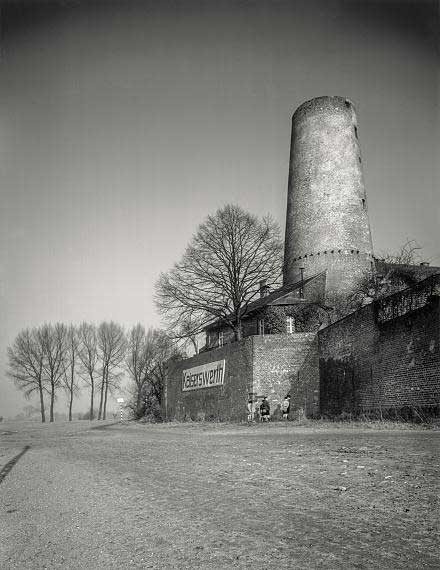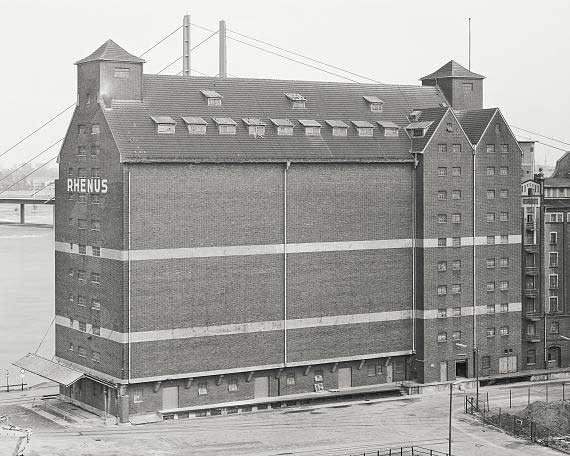Sifting through the archives of both August Sander and Bernd and Hilla Becher always brings to light new perspectives on their photographic work.
Thus, the exhibition dedicated to the two positions juxtaposes two previously largely unknown circles of motifs. On the one hand, there are more than 50 black-and-white photographs by August Sander, mainly from the 1930s, of history-charged water castles, industrial plants, and views of towns (including Düsseldorf), for example, which paint a multifaceted portrait of the cultural landscape of the Lower Rhine. On the other hand, equally black-and-white, large-format views by Bernd and Hilla Becher, taken in the Rhine Harbour in Düsseldorf and surrounding industrial areas, prove to be a discovery. Between 1978 and 1990, they had documented historic warehouses and functional buildings there in the objective style typical of their work.
August Sander (1876-1964), known for his important portrait work, also turned to the subject of landscape from his early independence as a photographer, which began in 1902 in Linz, Austria. For him, the landscape presented a challenge parallel to the portrait, and he pursued it with comparable objectives.

The selection of photographs made for this exhibition relates to the region of the Lower Rhine, an area to which August Sander turned, in addition to the Siebengebirge, the Middle Rhine, the Bergisches Land, the Westerwald, the Eifel, the Moselle region and the Saarland, apart from many landscape photographs taken on his trip to Sardinia in 1927. The August Sander Archive has around 250 negatives and just under as many original prints for the Lower Rhine area, and there is a large overlap of motifs between these two collections. For the current exhibition, however, new analog prints were created over the past two years using the original large-format glass negatives in the interest of a uniform presentation and for motifs for which no original prints have been preserved. The image details of the new prints are oriented as far as possible to the vintage material. All in all, the project is intended as a contribution to securing the archive and making the photographic material more visible to the interested public.
If one looks at Sander’s landscape views, one quickly realizes: His attention was less focused on an exaggerated scenic beauty in order to make it attractive to tourists, for example, than on a fundamentally scientific and cultural-historical interest that finds a characteristic pictorial form in the views he found. With his photographs, August Sander offers us both a topographical description of a landscape with a multitude of its typical moments and an insight into his view of his own reality of life as a natural as well as culturally historically evolved environment.
The eight large-scale exhibits with works by Bernd and Hilla Becher (1931-2007/1934-2015) focus on industrial functional buildings and constructions of the Düsseldorf Rhine Port. These were important in the context of storage, production and warehousing, as well as the onward transport of goods, and today only partially exist or are integrated into a new architecture. To a certain extent, they once again illuminate the theme of the cultural landscape of the Lower Rhine from their own perspective, whereby the area of industry and transport in particular is repeatedly addressed. The black-and-white photographs were taken in the 1970s to the 1990s, whereby only two motifs – one of them in a variant – have been published so far, namely in 2006 in the book about the Grain Elevators(Schirmer/Mosel plate 242, 243=variant). Accordingly, the exhibits include in particular warehouses, an old malt house, unloading and loading constructions, as well as silos, which Bernd and Hilla Becher have presented objectively sober, centrally placed in the picture. Beyond the precisely clear description of these image-defining motifs, however, the photographs also report – as a marginal note, as it were – on the locations of the buildings, which, upon closer inspection, is also capable of evoking memories of a bygone atmosphere and time. From the end of the 1970s, Düsseldorf’s Rhine Harbour – now the Media Harbour – underwent restructuring. This contributed to the fact that here, too, Bechers had the insistent task of documenting the few buildings of early 20th-century industrial architecture still preserved on site, some of which were on the verge of demolition at the time, in order to incorporate them into their work.
The exhibits have been prepared as high-resolution digital prints based on the artist couple’s original large-format negatives in Die Photographische Sammlung/SK Stiftung Kultur.

Kunstarchiv Kaiserswerth
21 Aug 2022
Suitbertus-Stiftsplatz 1
40489 Düsseldorf
www.duesseldorf.de/kulturamt/kunstarchiv-kaiserswerth






